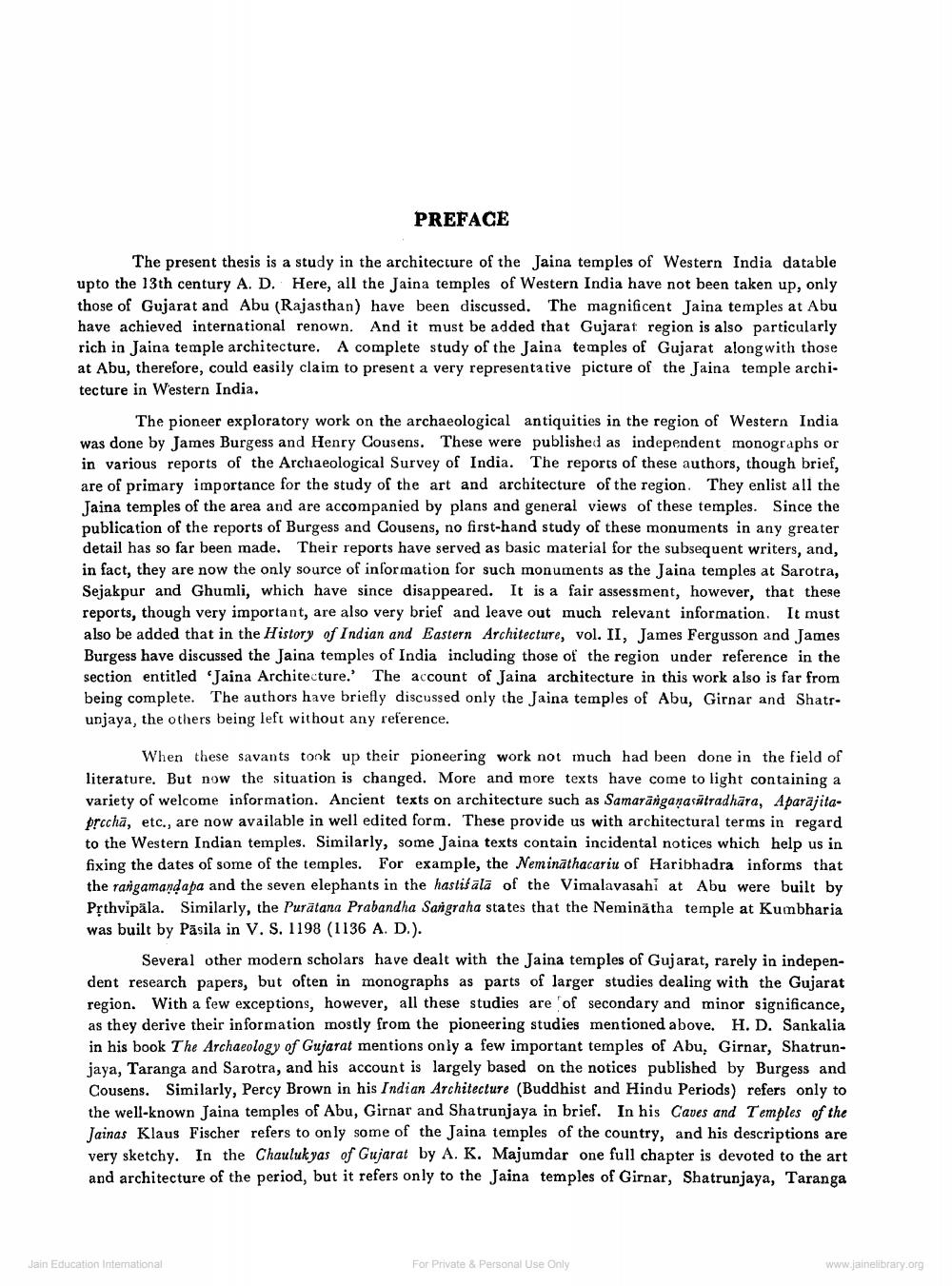Book Title: Jaina Temples of Western India Author(s): Harihar Singh Publisher: P V Research Institute Varanasi View full book textPage 6
________________ PREFACE The present thesis is a study in the architecture of the Jaina temples of Western India datable upto the 13th century A. D. Here, all the Jaina temples of Western India have not been taken up, only those of Gujarat and Abu (Rajasthan) have been discussed. The magnificent Jaina temples at Abu have achieved international renown. And it must be added that Gujarat region is also particularly rich in Jaina temple architecture. A complete study of the Jaina temples of Gujarat along with those at Abu, therefore, could easily claim to present a very representative picture of the Jaina temple architecture in Western India. The pioneer exploratory work on the archaeological antiquities in the region of Western India was done by James Burgess and Henry Cousens. These were published as independent monographs or in various reports of the Archaeological Survey of India. The reports of these authors, though brief, are of primary importance for the study of the art and architecture of the region. They enlist all the Jaina temples of the area and are accompanied by plans and general views of these temples. Since the publication of the reports of Burgess and Cousens, no first-hand study of these monuments in any greater detail has so far been made. Their reports have served as basic material for the subsequent writers, and, in fact, they are now the only source of information for such monuments as the Jaina temples at Sarotra, Sejakpur and Ghumli, which have since disappeared. It is a fair assessment, however, that these reports, though very important, are also very brief and leave out much relevant information. It must also be added that in the History of Indian and Eastern Architecture, vol. II, James Fergusson and James Burgess have discussed the Jaina temples of India including those of the region under reference in the section entitled 'Jaina Architecture. The account of Jaina architecture in this work also is far from being complete. The authors have briefly discussed only the Jaina temples of Abu, Girnar and Shatrunjaya, the others being left without any reference. When these savants took up their pioneering work not much had been done in the field of literature. But now the situation is changed. More and more texts have come to light containing a variety of welcome information. Ancient texts on architecture such as Samaränganasūtradhāra, Aparajitaprocha, etc., are now available in well edited form. These provide us with architectural terms in regard to the Western Indian temples. Similarly, some Jaina texts contain incidental notices which help us in fixing the dates of some of the temples. For example, the Nemināthacariu of Haribhadra informs that the rangamandapa and the seven elephants in the hastiśālā of the Vimalavasahi at Abu were built by Pșthvipäla. Similarly, the Purātana Prabandha Sangraha states that the Neminātha temple at Kumbharia was built by Pasila in V. S. 1198 (1136 A. D.). Several other modern scholars have dealt with the Jaina temples of Gujarat, rarely in independent research papers, but often in monographs as parts of larger studies dealing with the Gujarat region. With a few exceptions, however, all these studies are of secondary and minor significance, as they derive their information mostly from the pioneering studies mentioned above. H. D. Sankalia in his book The Archaeology of Gujarat mentions only a few important temples of Abu, Girnar, Shatrunjaya, Taranga and Sarotra, and his account is largely based on the notices published by Burgess and Cousens. Similarly, Percy Brown in his Indian Architecture (Buddhist and Hindu Periods) refers only to the well-known Jaina temples of Abu, Girnar and Shatrunjaya in brief. In his Caves and Temples of the Jainas Klaus Fischer refers to only some of the Jaina temples of the country, and his descriptions are very sketchy. In the Chaulukyas of Gujarat by A. K. Majumdar one full chapter is devoted to the art and architecture of the period, but it refers only to the Jaina temples of Girnar, Shatrunjaya, Taranga Jain Education International For Private & Personal use only www.jainelibrary.orgPage Navigation
1 ... 4 5 6 7 8 9 10 11 12 13 14 15 16 17 18 19 20 21 22 23 24 25 26 27 28 29 30 31 32 33 34 35 36 37 38 39 40 41 42 43 44 45 46 47 48 49 50 51 52 53 54 55 56 57 58 59 60 61 62 ... 362
